Leadership: Individualism to Collectivity - A Comprehensive Review
VerifiedAdded on 2021/08/03
|26
|8904
|19
Essay
AI Summary
This essay provides a comprehensive review of the evolution of leadership, transitioning from individualistic approaches to collectivist models. The study explores three key themes: distributed leadership, millennial leadership, and the dark side of leadership. The introduction sets the stage by highlighting the evolving nature of leadership in response to the challenges of a rapidly changing world, emphasizing the need for leaders to balance various aspects such as perspective, motivation, planning, and renewal. The theoretical framework establishes the foundation for understanding the shift from individual to collective leadership, including the impact of globalization and cultural dimensions. The essay delves into each theme, analyzing the dynamics of distributed leadership, which emphasizes workplace collaboration and the sharing of expertise. Millennial leadership is explored for its focus on organizational advancement, while the dark side of leadership examines how certain behaviors can lead to organizational destruction. Theoretical and empirical papers are utilized to analyze the methodologies and implications of each theme, with a conclusion summarizing the overall review and its significance in the current leadership landscape. The paper also presents real-world examples to illustrate the tension between individualism and collectivism in different cultural contexts, such as the example of McDonald's in India.
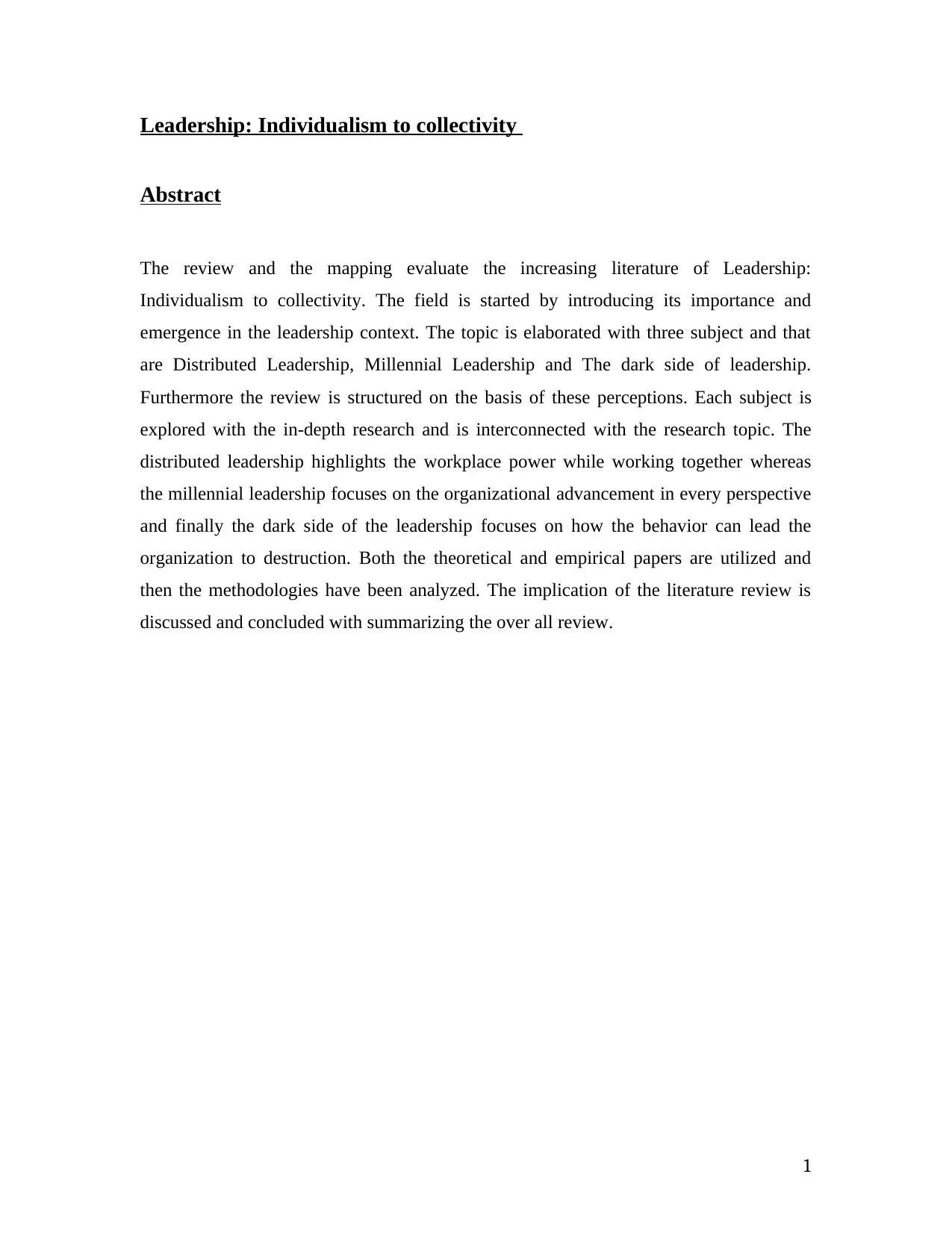
Leadership: Individualism to collectivity
Abstract
The review and the mapping evaluate the increasing literature of Leadership:
Individualism to collectivity. The field is started by introducing its importance and
emergence in the leadership context. The topic is elaborated with three subject and that
are Distributed Leadership, Millennial Leadership and The dark side of leadership.
Furthermore the review is structured on the basis of these perceptions. Each subject is
explored with the in-depth research and is interconnected with the research topic. The
distributed leadership highlights the workplace power while working together whereas
the millennial leadership focuses on the organizational advancement in every perspective
and finally the dark side of the leadership focuses on how the behavior can lead the
organization to destruction. Both the theoretical and empirical papers are utilized and
then the methodologies have been analyzed. The implication of the literature review is
discussed and concluded with summarizing the over all review.
1
Abstract
The review and the mapping evaluate the increasing literature of Leadership:
Individualism to collectivity. The field is started by introducing its importance and
emergence in the leadership context. The topic is elaborated with three subject and that
are Distributed Leadership, Millennial Leadership and The dark side of leadership.
Furthermore the review is structured on the basis of these perceptions. Each subject is
explored with the in-depth research and is interconnected with the research topic. The
distributed leadership highlights the workplace power while working together whereas
the millennial leadership focuses on the organizational advancement in every perspective
and finally the dark side of the leadership focuses on how the behavior can lead the
organization to destruction. Both the theoretical and empirical papers are utilized and
then the methodologies have been analyzed. The implication of the literature review is
discussed and concluded with summarizing the over all review.
1
Paraphrase This Document
Need a fresh take? Get an instant paraphrase of this document with our AI Paraphraser
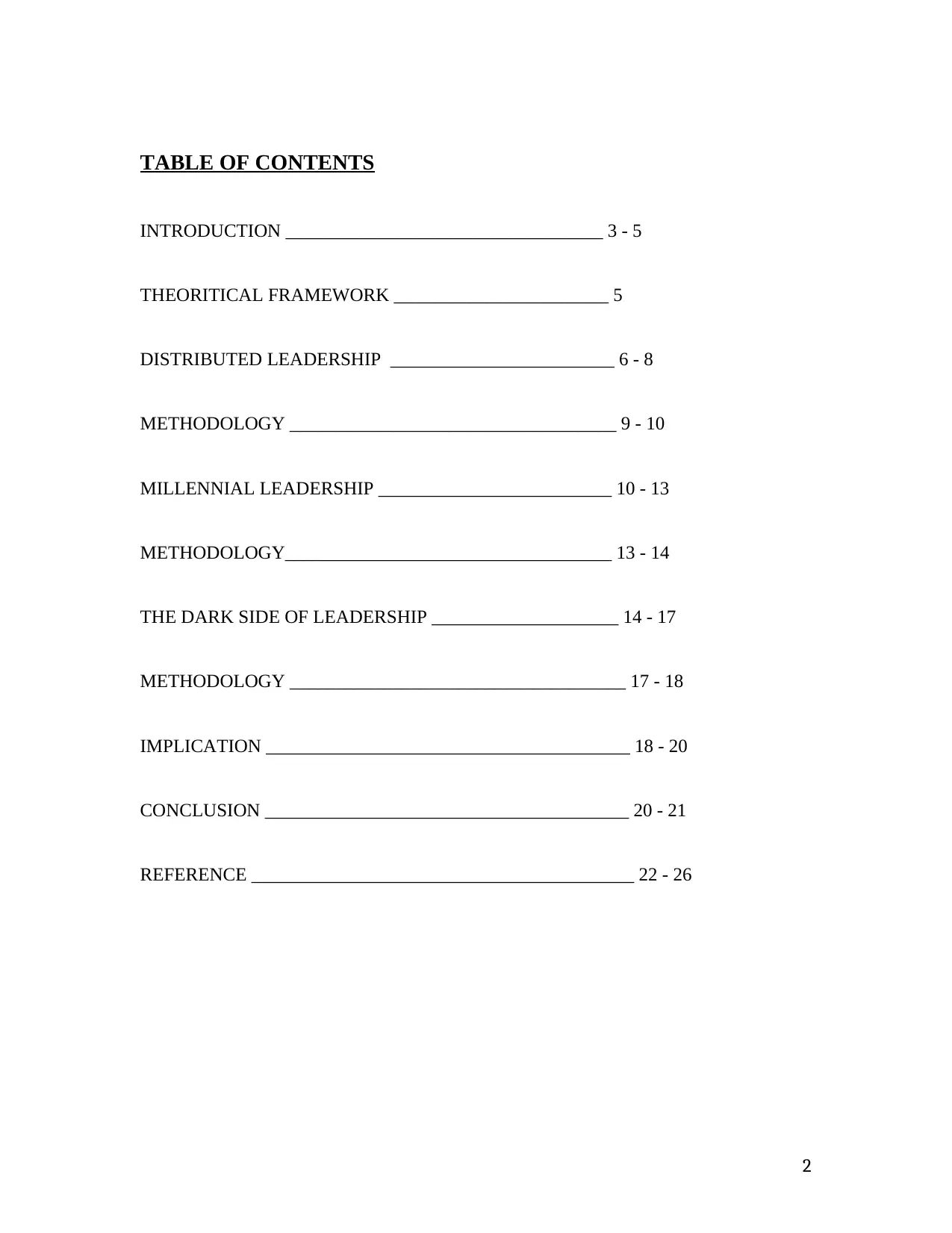
TABLE OF CONTENTS
INTRODUCTION __________________________________ 3 - 5
THEORITICAL FRAMEWORK _______________________ 5
DISTRIBUTED LEADERSHIP ________________________ 6 - 8
METHODOLOGY ___________________________________ 9 - 10
MILLENNIAL LEADERSHIP _________________________ 10 - 13
METHODOLOGY___________________________________ 13 - 14
THE DARK SIDE OF LEADERSHIP ____________________ 14 - 17
METHODOLOGY ____________________________________ 17 - 18
IMPLICATION _______________________________________ 18 - 20
CONCLUSION _______________________________________ 20 - 21
REFERENCE _________________________________________ 22 - 26
2
INTRODUCTION __________________________________ 3 - 5
THEORITICAL FRAMEWORK _______________________ 5
DISTRIBUTED LEADERSHIP ________________________ 6 - 8
METHODOLOGY ___________________________________ 9 - 10
MILLENNIAL LEADERSHIP _________________________ 10 - 13
METHODOLOGY___________________________________ 13 - 14
THE DARK SIDE OF LEADERSHIP ____________________ 14 - 17
METHODOLOGY ____________________________________ 17 - 18
IMPLICATION _______________________________________ 18 - 20
CONCLUSION _______________________________________ 20 - 21
REFERENCE _________________________________________ 22 - 26
2
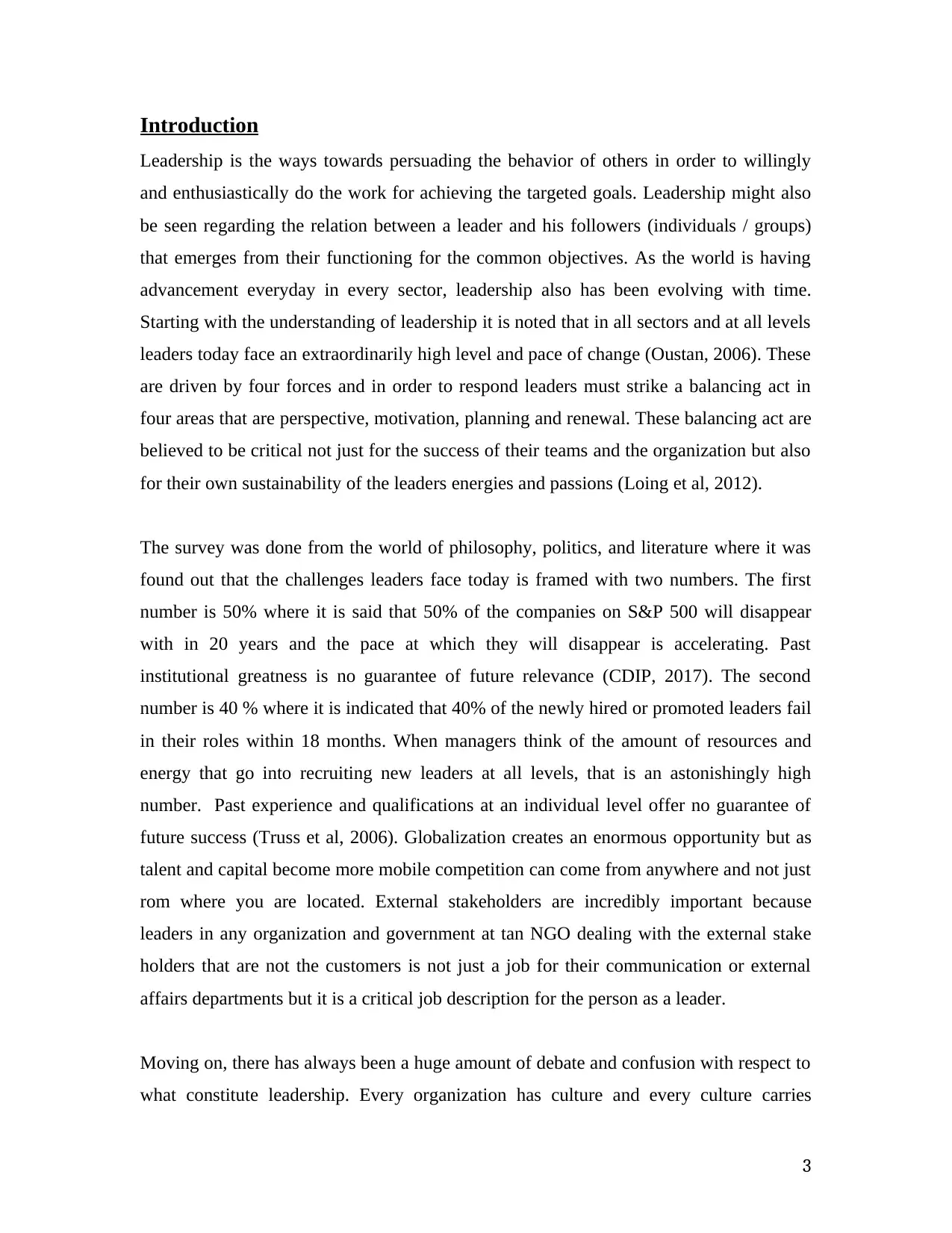
Introduction
Leadership is the ways towards persuading the behavior of others in order to willingly
and enthusiastically do the work for achieving the targeted goals. Leadership might also
be seen regarding the relation between a leader and his followers (individuals / groups)
that emerges from their functioning for the common objectives. As the world is having
advancement everyday in every sector, leadership also has been evolving with time.
Starting with the understanding of leadership it is noted that in all sectors and at all levels
leaders today face an extraordinarily high level and pace of change (Oustan, 2006). These
are driven by four forces and in order to respond leaders must strike a balancing act in
four areas that are perspective, motivation, planning and renewal. These balancing act are
believed to be critical not just for the success of their teams and the organization but also
for their own sustainability of the leaders energies and passions (Loing et al, 2012).
The survey was done from the world of philosophy, politics, and literature where it was
found out that the challenges leaders face today is framed with two numbers. The first
number is 50% where it is said that 50% of the companies on S&P 500 will disappear
with in 20 years and the pace at which they will disappear is accelerating. Past
institutional greatness is no guarantee of future relevance (CDIP, 2017). The second
number is 40 % where it is indicated that 40% of the newly hired or promoted leaders fail
in their roles within 18 months. When managers think of the amount of resources and
energy that go into recruiting new leaders at all levels, that is an astonishingly high
number. Past experience and qualifications at an individual level offer no guarantee of
future success (Truss et al, 2006). Globalization creates an enormous opportunity but as
talent and capital become more mobile competition can come from anywhere and not just
rom where you are located. External stakeholders are incredibly important because
leaders in any organization and government at tan NGO dealing with the external stake
holders that are not the customers is not just a job for their communication or external
affairs departments but it is a critical job description for the person as a leader.
Moving on, there has always been a huge amount of debate and confusion with respect to
what constitute leadership. Every organization has culture and every culture carries
3
Leadership is the ways towards persuading the behavior of others in order to willingly
and enthusiastically do the work for achieving the targeted goals. Leadership might also
be seen regarding the relation between a leader and his followers (individuals / groups)
that emerges from their functioning for the common objectives. As the world is having
advancement everyday in every sector, leadership also has been evolving with time.
Starting with the understanding of leadership it is noted that in all sectors and at all levels
leaders today face an extraordinarily high level and pace of change (Oustan, 2006). These
are driven by four forces and in order to respond leaders must strike a balancing act in
four areas that are perspective, motivation, planning and renewal. These balancing act are
believed to be critical not just for the success of their teams and the organization but also
for their own sustainability of the leaders energies and passions (Loing et al, 2012).
The survey was done from the world of philosophy, politics, and literature where it was
found out that the challenges leaders face today is framed with two numbers. The first
number is 50% where it is said that 50% of the companies on S&P 500 will disappear
with in 20 years and the pace at which they will disappear is accelerating. Past
institutional greatness is no guarantee of future relevance (CDIP, 2017). The second
number is 40 % where it is indicated that 40% of the newly hired or promoted leaders fail
in their roles within 18 months. When managers think of the amount of resources and
energy that go into recruiting new leaders at all levels, that is an astonishingly high
number. Past experience and qualifications at an individual level offer no guarantee of
future success (Truss et al, 2006). Globalization creates an enormous opportunity but as
talent and capital become more mobile competition can come from anywhere and not just
rom where you are located. External stakeholders are incredibly important because
leaders in any organization and government at tan NGO dealing with the external stake
holders that are not the customers is not just a job for their communication or external
affairs departments but it is a critical job description for the person as a leader.
Moving on, there has always been a huge amount of debate and confusion with respect to
what constitute leadership. Every organization has culture and every culture carries
3
⊘ This is a preview!⊘
Do you want full access?
Subscribe today to unlock all pages.

Trusted by 1+ million students worldwide
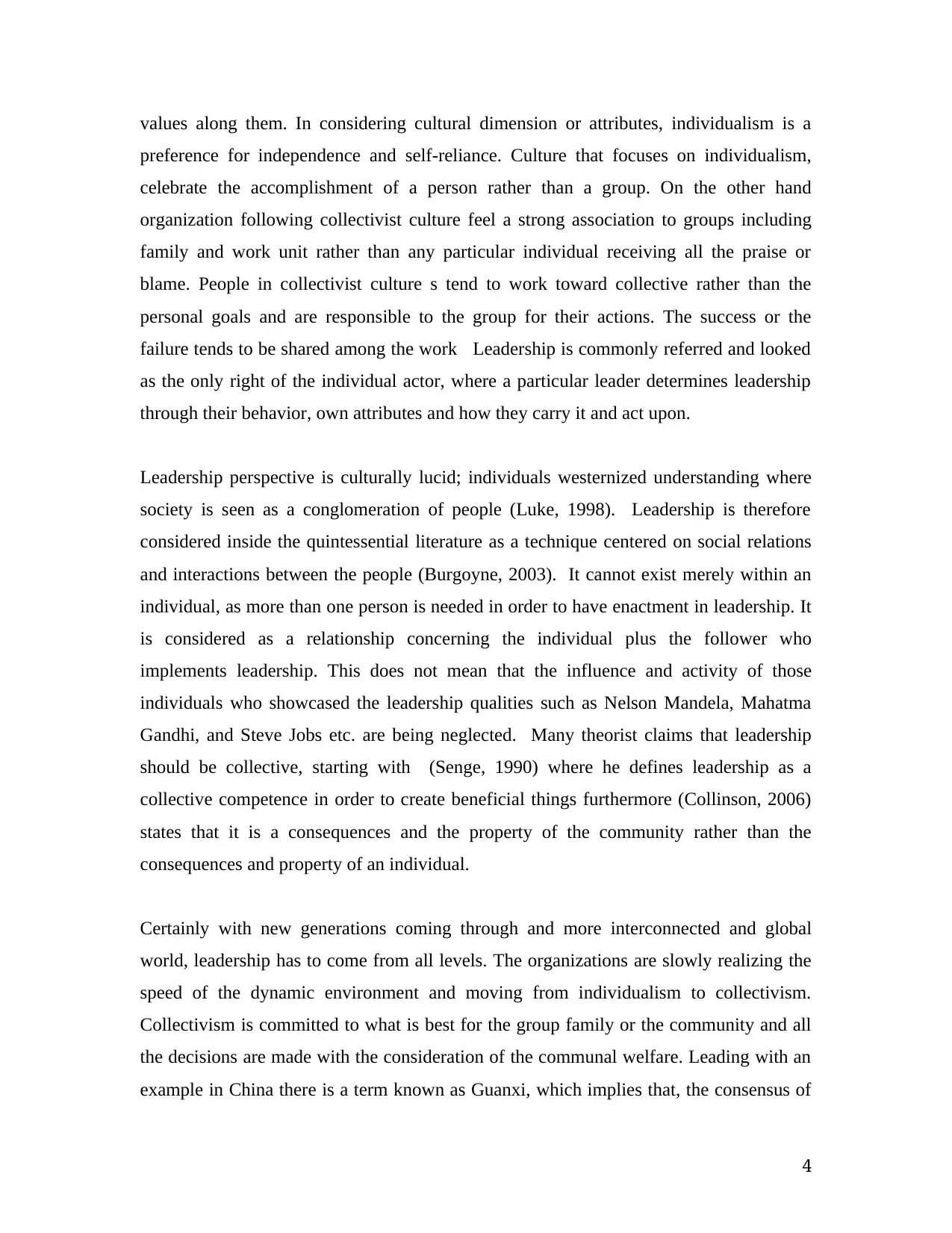
values along them. In considering cultural dimension or attributes, individualism is a
preference for independence and self-reliance. Culture that focuses on individualism,
celebrate the accomplishment of a person rather than a group. On the other hand
organization following collectivist culture feel a strong association to groups including
family and work unit rather than any particular individual receiving all the praise or
blame. People in collectivist culture s tend to work toward collective rather than the
personal goals and are responsible to the group for their actions. The success or the
failure tends to be shared among the work Leadership is commonly referred and looked
as the only right of the individual actor, where a particular leader determines leadership
through their behavior, own attributes and how they carry it and act upon.
Leadership perspective is culturally lucid; individuals westernized understanding where
society is seen as a conglomeration of people (Luke, 1998). Leadership is therefore
considered inside the quintessential literature as a technique centered on social relations
and interactions between the people (Burgoyne, 2003). It cannot exist merely within an
individual, as more than one person is needed in order to have enactment in leadership. It
is considered as a relationship concerning the individual plus the follower who
implements leadership. This does not mean that the influence and activity of those
individuals who showcased the leadership qualities such as Nelson Mandela, Mahatma
Gandhi, and Steve Jobs etc. are being neglected. Many theorist claims that leadership
should be collective, starting with (Senge, 1990) where he defines leadership as a
collective competence in order to create beneficial things furthermore (Collinson, 2006)
states that it is a consequences and the property of the community rather than the
consequences and property of an individual.
Certainly with new generations coming through and more interconnected and global
world, leadership has to come from all levels. The organizations are slowly realizing the
speed of the dynamic environment and moving from individualism to collectivism.
Collectivism is committed to what is best for the group family or the community and all
the decisions are made with the consideration of the communal welfare. Leading with an
example in China there is a term known as Guanxi, which implies that, the consensus of
4
preference for independence and self-reliance. Culture that focuses on individualism,
celebrate the accomplishment of a person rather than a group. On the other hand
organization following collectivist culture feel a strong association to groups including
family and work unit rather than any particular individual receiving all the praise or
blame. People in collectivist culture s tend to work toward collective rather than the
personal goals and are responsible to the group for their actions. The success or the
failure tends to be shared among the work Leadership is commonly referred and looked
as the only right of the individual actor, where a particular leader determines leadership
through their behavior, own attributes and how they carry it and act upon.
Leadership perspective is culturally lucid; individuals westernized understanding where
society is seen as a conglomeration of people (Luke, 1998). Leadership is therefore
considered inside the quintessential literature as a technique centered on social relations
and interactions between the people (Burgoyne, 2003). It cannot exist merely within an
individual, as more than one person is needed in order to have enactment in leadership. It
is considered as a relationship concerning the individual plus the follower who
implements leadership. This does not mean that the influence and activity of those
individuals who showcased the leadership qualities such as Nelson Mandela, Mahatma
Gandhi, and Steve Jobs etc. are being neglected. Many theorist claims that leadership
should be collective, starting with (Senge, 1990) where he defines leadership as a
collective competence in order to create beneficial things furthermore (Collinson, 2006)
states that it is a consequences and the property of the community rather than the
consequences and property of an individual.
Certainly with new generations coming through and more interconnected and global
world, leadership has to come from all levels. The organizations are slowly realizing the
speed of the dynamic environment and moving from individualism to collectivism.
Collectivism is committed to what is best for the group family or the community and all
the decisions are made with the consideration of the communal welfare. Leading with an
example in China there is a term known as Guanxi, which implies that, the consensus of
4
Paraphrase This Document
Need a fresh take? Get an instant paraphrase of this document with our AI Paraphraser
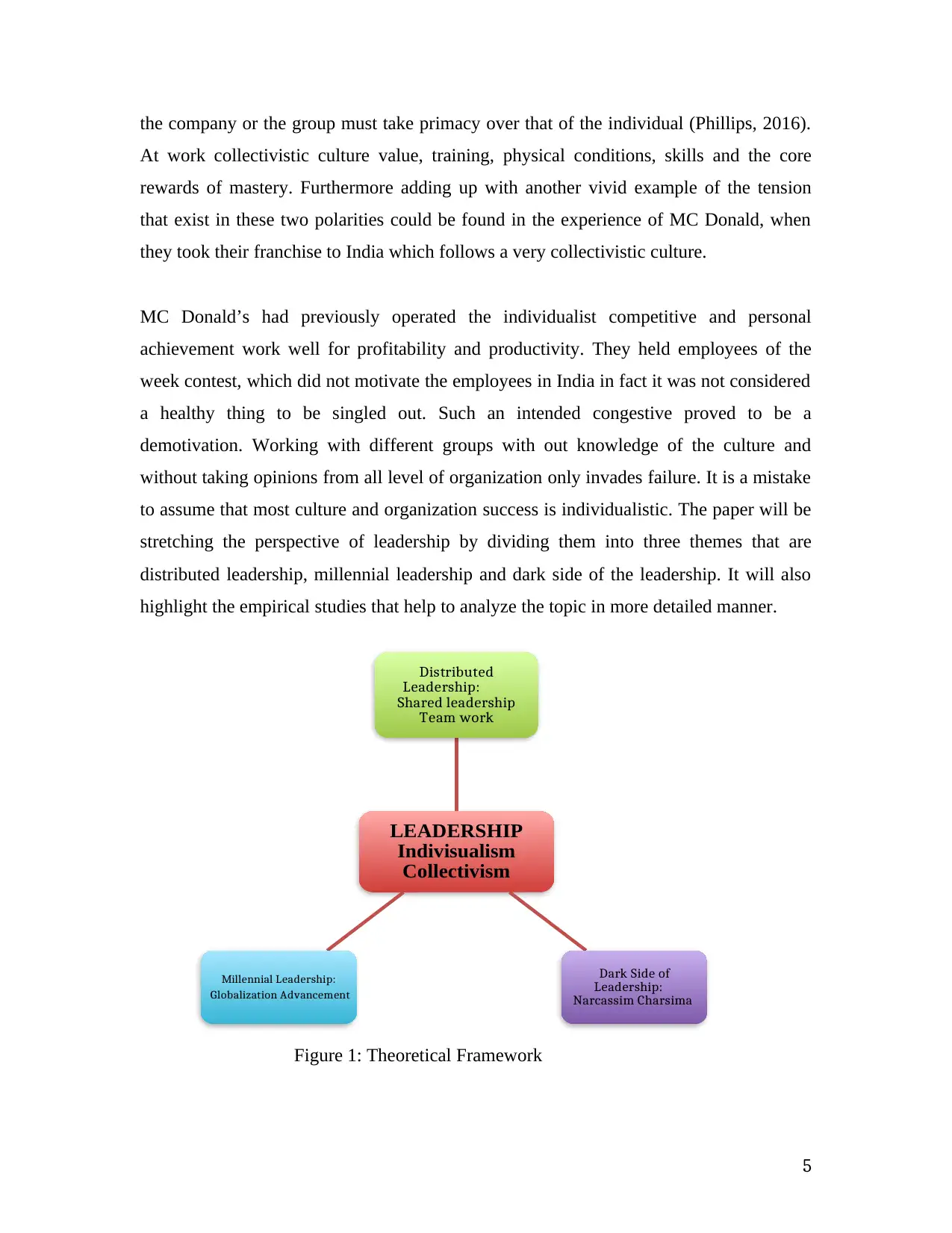
the company or the group must take primacy over that of the individual (Phillips, 2016).
At work collectivistic culture value, training, physical conditions, skills and the core
rewards of mastery. Furthermore adding up with another vivid example of the tension
that exist in these two polarities could be found in the experience of MC Donald, when
they took their franchise to India which follows a very collectivistic culture.
MC Donald’s had previously operated the individualist competitive and personal
achievement work well for profitability and productivity. They held employees of the
week contest, which did not motivate the employees in India in fact it was not considered
a healthy thing to be singled out. Such an intended congestive proved to be a
demotivation. Working with different groups with out knowledge of the culture and
without taking opinions from all level of organization only invades failure. It is a mistake
to assume that most culture and organization success is individualistic. The paper will be
stretching the perspective of leadership by dividing them into three themes that are
distributed leadership, millennial leadership and dark side of the leadership. It will also
highlight the empirical studies that help to analyze the topic in more detailed manner.
Figure 1: Theoretical Framework
LEADERSHIP
Indivisualism
Collectivism
Distributed
Leadership:
Shared leadership
Team work
Dark Side of
Leadership:
Narcassim Charsima
Millennial Leadership:
Globalization Advancement
5
At work collectivistic culture value, training, physical conditions, skills and the core
rewards of mastery. Furthermore adding up with another vivid example of the tension
that exist in these two polarities could be found in the experience of MC Donald, when
they took their franchise to India which follows a very collectivistic culture.
MC Donald’s had previously operated the individualist competitive and personal
achievement work well for profitability and productivity. They held employees of the
week contest, which did not motivate the employees in India in fact it was not considered
a healthy thing to be singled out. Such an intended congestive proved to be a
demotivation. Working with different groups with out knowledge of the culture and
without taking opinions from all level of organization only invades failure. It is a mistake
to assume that most culture and organization success is individualistic. The paper will be
stretching the perspective of leadership by dividing them into three themes that are
distributed leadership, millennial leadership and dark side of the leadership. It will also
highlight the empirical studies that help to analyze the topic in more detailed manner.
Figure 1: Theoretical Framework
LEADERSHIP
Indivisualism
Collectivism
Distributed
Leadership:
Shared leadership
Team work
Dark Side of
Leadership:
Narcassim Charsima
Millennial Leadership:
Globalization Advancement
5
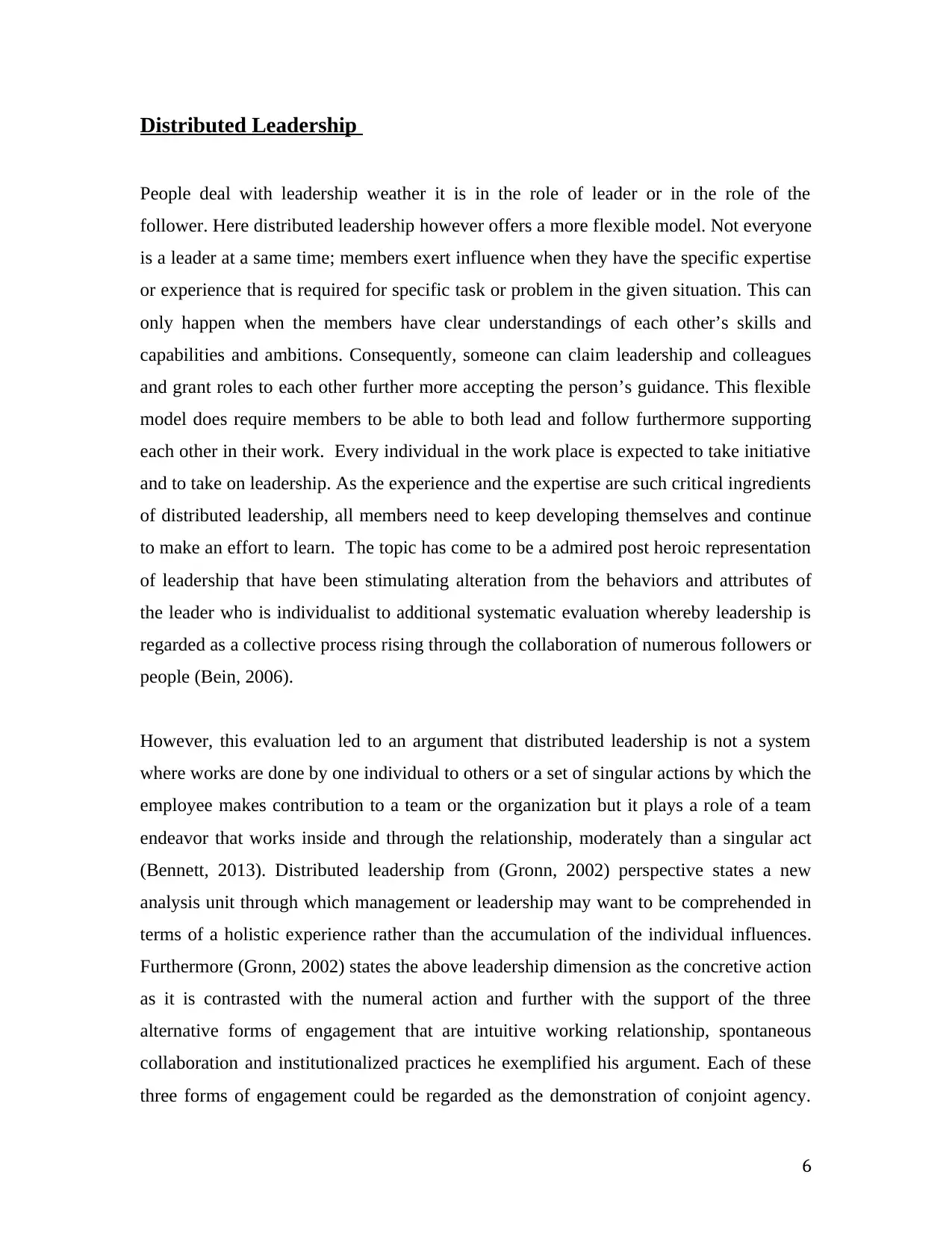
Distributed Leadership
People deal with leadership weather it is in the role of leader or in the role of the
follower. Here distributed leadership however offers a more flexible model. Not everyone
is a leader at a same time; members exert influence when they have the specific expertise
or experience that is required for specific task or problem in the given situation. This can
only happen when the members have clear understandings of each other’s skills and
capabilities and ambitions. Consequently, someone can claim leadership and colleagues
and grant roles to each other further more accepting the person’s guidance. This flexible
model does require members to be able to both lead and follow furthermore supporting
each other in their work. Every individual in the work place is expected to take initiative
and to take on leadership. As the experience and the expertise are such critical ingredients
of distributed leadership, all members need to keep developing themselves and continue
to make an effort to learn. The topic has come to be a admired post heroic representation
of leadership that have been stimulating alteration from the behaviors and attributes of
the leader who is individualist to additional systematic evaluation whereby leadership is
regarded as a collective process rising through the collaboration of numerous followers or
people (Bein, 2006).
However, this evaluation led to an argument that distributed leadership is not a system
where works are done by one individual to others or a set of singular actions by which the
employee makes contribution to a team or the organization but it plays a role of a team
endeavor that works inside and through the relationship, moderately than a singular act
(Bennett, 2013). Distributed leadership from (Gronn, 2002) perspective states a new
analysis unit through which management or leadership may want to be comprehended in
terms of a holistic experience rather than the accumulation of the individual influences.
Furthermore (Gronn, 2002) states the above leadership dimension as the concretive action
as it is contrasted with the numeral action and further with the support of the three
alternative forms of engagement that are intuitive working relationship, spontaneous
collaboration and institutionalized practices he exemplified his argument. Each of these
three forms of engagement could be regarded as the demonstration of conjoint agency.
6
People deal with leadership weather it is in the role of leader or in the role of the
follower. Here distributed leadership however offers a more flexible model. Not everyone
is a leader at a same time; members exert influence when they have the specific expertise
or experience that is required for specific task or problem in the given situation. This can
only happen when the members have clear understandings of each other’s skills and
capabilities and ambitions. Consequently, someone can claim leadership and colleagues
and grant roles to each other further more accepting the person’s guidance. This flexible
model does require members to be able to both lead and follow furthermore supporting
each other in their work. Every individual in the work place is expected to take initiative
and to take on leadership. As the experience and the expertise are such critical ingredients
of distributed leadership, all members need to keep developing themselves and continue
to make an effort to learn. The topic has come to be a admired post heroic representation
of leadership that have been stimulating alteration from the behaviors and attributes of
the leader who is individualist to additional systematic evaluation whereby leadership is
regarded as a collective process rising through the collaboration of numerous followers or
people (Bein, 2006).
However, this evaluation led to an argument that distributed leadership is not a system
where works are done by one individual to others or a set of singular actions by which the
employee makes contribution to a team or the organization but it plays a role of a team
endeavor that works inside and through the relationship, moderately than a singular act
(Bennett, 2013). Distributed leadership from (Gronn, 2002) perspective states a new
analysis unit through which management or leadership may want to be comprehended in
terms of a holistic experience rather than the accumulation of the individual influences.
Furthermore (Gronn, 2002) states the above leadership dimension as the concretive action
as it is contrasted with the numeral action and further with the support of the three
alternative forms of engagement that are intuitive working relationship, spontaneous
collaboration and institutionalized practices he exemplified his argument. Each of these
three forms of engagement could be regarded as the demonstration of conjoint agency.
6
⊘ This is a preview!⊘
Do you want full access?
Subscribe today to unlock all pages.

Trusted by 1+ million students worldwide
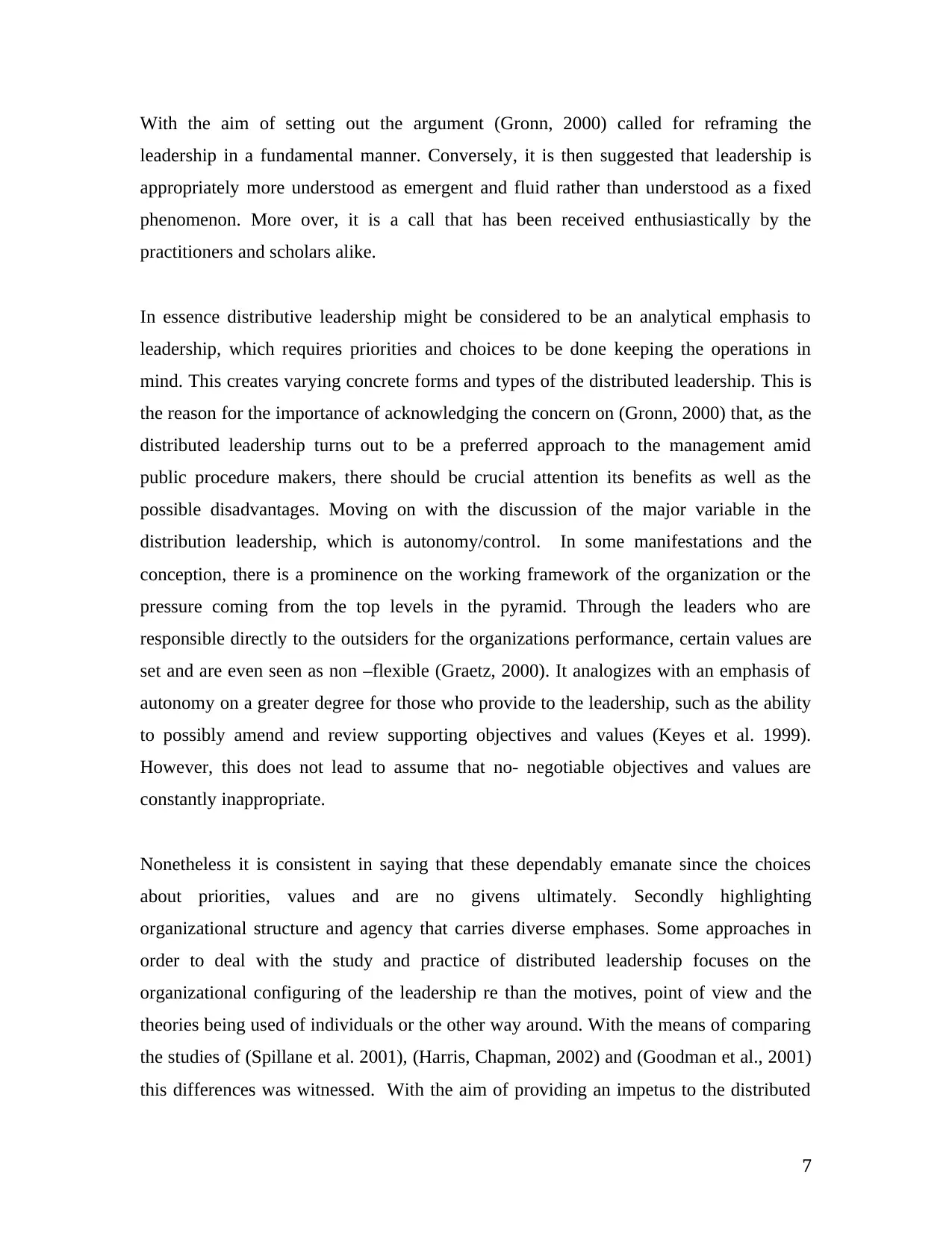
With the aim of setting out the argument (Gronn, 2000) called for reframing the
leadership in a fundamental manner. Conversely, it is then suggested that leadership is
appropriately more understood as emergent and fluid rather than understood as a fixed
phenomenon. More over, it is a call that has been received enthusiastically by the
practitioners and scholars alike.
In essence distributive leadership might be considered to be an analytical emphasis to
leadership, which requires priorities and choices to be done keeping the operations in
mind. This creates varying concrete forms and types of the distributed leadership. This is
the reason for the importance of acknowledging the concern on (Gronn, 2000) that, as the
distributed leadership turns out to be a preferred approach to the management amid
public procedure makers, there should be crucial attention its benefits as well as the
possible disadvantages. Moving on with the discussion of the major variable in the
distribution leadership, which is autonomy/control. In some manifestations and the
conception, there is a prominence on the working framework of the organization or the
pressure coming from the top levels in the pyramid. Through the leaders who are
responsible directly to the outsiders for the organizations performance, certain values are
set and are even seen as non –flexible (Graetz, 2000). It analogizes with an emphasis of
autonomy on a greater degree for those who provide to the leadership, such as the ability
to possibly amend and review supporting objectives and values (Keyes et al. 1999).
However, this does not lead to assume that no- negotiable objectives and values are
constantly inappropriate.
Nonetheless it is consistent in saying that these dependably emanate since the choices
about priorities, values and are no givens ultimately. Secondly highlighting
organizational structure and agency that carries diverse emphases. Some approaches in
order to deal with the study and practice of distributed leadership focuses on the
organizational configuring of the leadership re than the motives, point of view and the
theories being used of individuals or the other way around. With the means of comparing
the studies of (Spillane et al. 2001), (Harris, Chapman, 2002) and (Goodman et al., 2001)
this differences was witnessed. With the aim of providing an impetus to the distributed
7
leadership in a fundamental manner. Conversely, it is then suggested that leadership is
appropriately more understood as emergent and fluid rather than understood as a fixed
phenomenon. More over, it is a call that has been received enthusiastically by the
practitioners and scholars alike.
In essence distributive leadership might be considered to be an analytical emphasis to
leadership, which requires priorities and choices to be done keeping the operations in
mind. This creates varying concrete forms and types of the distributed leadership. This is
the reason for the importance of acknowledging the concern on (Gronn, 2000) that, as the
distributed leadership turns out to be a preferred approach to the management amid
public procedure makers, there should be crucial attention its benefits as well as the
possible disadvantages. Moving on with the discussion of the major variable in the
distribution leadership, which is autonomy/control. In some manifestations and the
conception, there is a prominence on the working framework of the organization or the
pressure coming from the top levels in the pyramid. Through the leaders who are
responsible directly to the outsiders for the organizations performance, certain values are
set and are even seen as non –flexible (Graetz, 2000). It analogizes with an emphasis of
autonomy on a greater degree for those who provide to the leadership, such as the ability
to possibly amend and review supporting objectives and values (Keyes et al. 1999).
However, this does not lead to assume that no- negotiable objectives and values are
constantly inappropriate.
Nonetheless it is consistent in saying that these dependably emanate since the choices
about priorities, values and are no givens ultimately. Secondly highlighting
organizational structure and agency that carries diverse emphases. Some approaches in
order to deal with the study and practice of distributed leadership focuses on the
organizational configuring of the leadership re than the motives, point of view and the
theories being used of individuals or the other way around. With the means of comparing
the studies of (Spillane et al. 2001), (Harris, Chapman, 2002) and (Goodman et al., 2001)
this differences was witnessed. With the aim of providing an impetus to the distributed
7
Paraphrase This Document
Need a fresh take? Get an instant paraphrase of this document with our AI Paraphraser
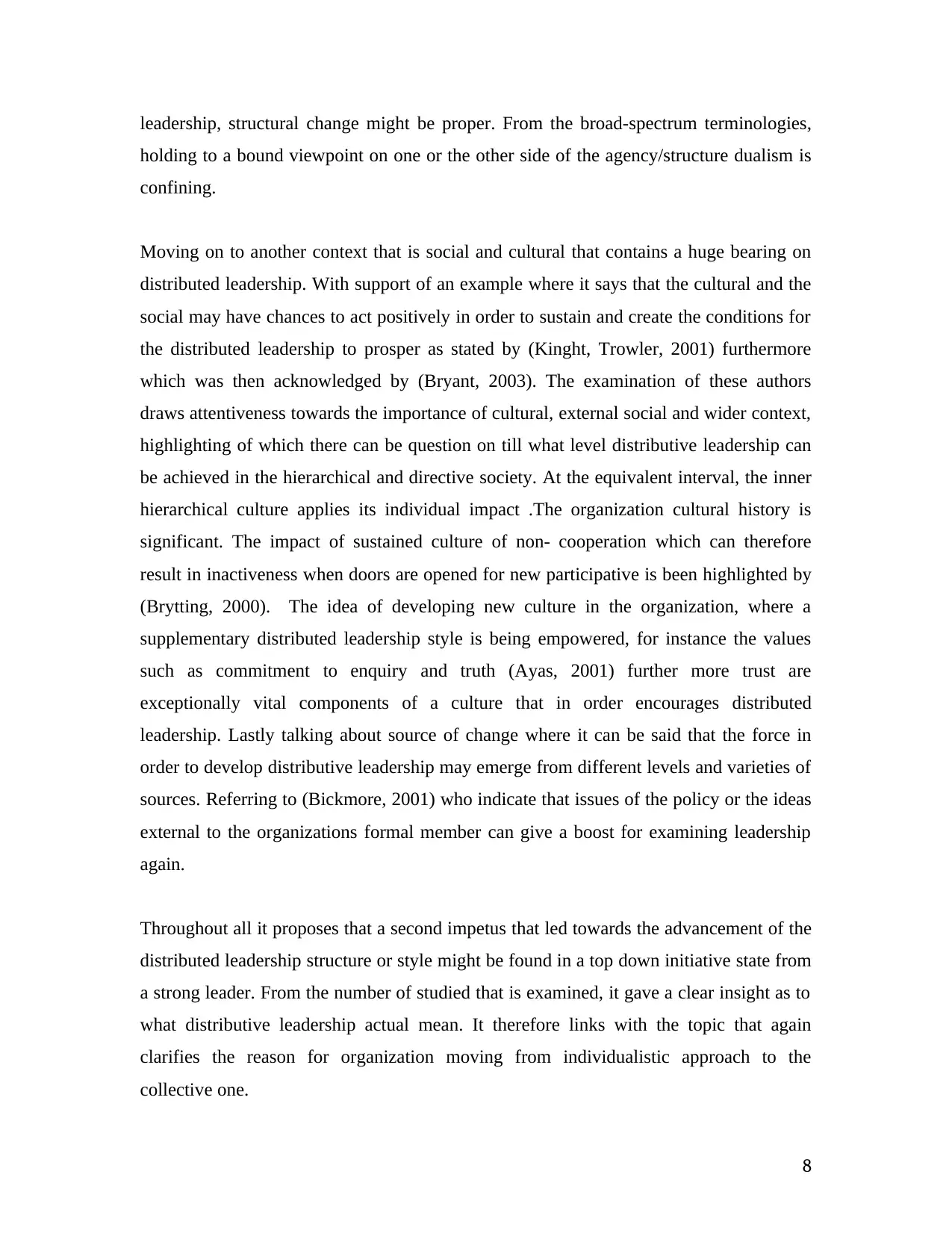
leadership, structural change might be proper. From the broad-spectrum terminologies,
holding to a bound viewpoint on one or the other side of the agency/structure dualism is
confining.
Moving on to another context that is social and cultural that contains a huge bearing on
distributed leadership. With support of an example where it says that the cultural and the
social may have chances to act positively in order to sustain and create the conditions for
the distributed leadership to prosper as stated by (Kinght, Trowler, 2001) furthermore
which was then acknowledged by (Bryant, 2003). The examination of these authors
draws attentiveness towards the importance of cultural, external social and wider context,
highlighting of which there can be question on till what level distributive leadership can
be achieved in the hierarchical and directive society. At the equivalent interval, the inner
hierarchical culture applies its individual impact .The organization cultural history is
significant. The impact of sustained culture of non- cooperation which can therefore
result in inactiveness when doors are opened for new participative is been highlighted by
(Brytting, 2000). The idea of developing new culture in the organization, where a
supplementary distributed leadership style is being empowered, for instance the values
such as commitment to enquiry and truth (Ayas, 2001) further more trust are
exceptionally vital components of a culture that in order encourages distributed
leadership. Lastly talking about source of change where it can be said that the force in
order to develop distributive leadership may emerge from different levels and varieties of
sources. Referring to (Bickmore, 2001) who indicate that issues of the policy or the ideas
external to the organizations formal member can give a boost for examining leadership
again.
Throughout all it proposes that a second impetus that led towards the advancement of the
distributed leadership structure or style might be found in a top down initiative state from
a strong leader. From the number of studied that is examined, it gave a clear insight as to
what distributive leadership actual mean. It therefore links with the topic that again
clarifies the reason for organization moving from individualistic approach to the
collective one.
8
holding to a bound viewpoint on one or the other side of the agency/structure dualism is
confining.
Moving on to another context that is social and cultural that contains a huge bearing on
distributed leadership. With support of an example where it says that the cultural and the
social may have chances to act positively in order to sustain and create the conditions for
the distributed leadership to prosper as stated by (Kinght, Trowler, 2001) furthermore
which was then acknowledged by (Bryant, 2003). The examination of these authors
draws attentiveness towards the importance of cultural, external social and wider context,
highlighting of which there can be question on till what level distributive leadership can
be achieved in the hierarchical and directive society. At the equivalent interval, the inner
hierarchical culture applies its individual impact .The organization cultural history is
significant. The impact of sustained culture of non- cooperation which can therefore
result in inactiveness when doors are opened for new participative is been highlighted by
(Brytting, 2000). The idea of developing new culture in the organization, where a
supplementary distributed leadership style is being empowered, for instance the values
such as commitment to enquiry and truth (Ayas, 2001) further more trust are
exceptionally vital components of a culture that in order encourages distributed
leadership. Lastly talking about source of change where it can be said that the force in
order to develop distributive leadership may emerge from different levels and varieties of
sources. Referring to (Bickmore, 2001) who indicate that issues of the policy or the ideas
external to the organizations formal member can give a boost for examining leadership
again.
Throughout all it proposes that a second impetus that led towards the advancement of the
distributed leadership structure or style might be found in a top down initiative state from
a strong leader. From the number of studied that is examined, it gave a clear insight as to
what distributive leadership actual mean. It therefore links with the topic that again
clarifies the reason for organization moving from individualistic approach to the
collective one.
8
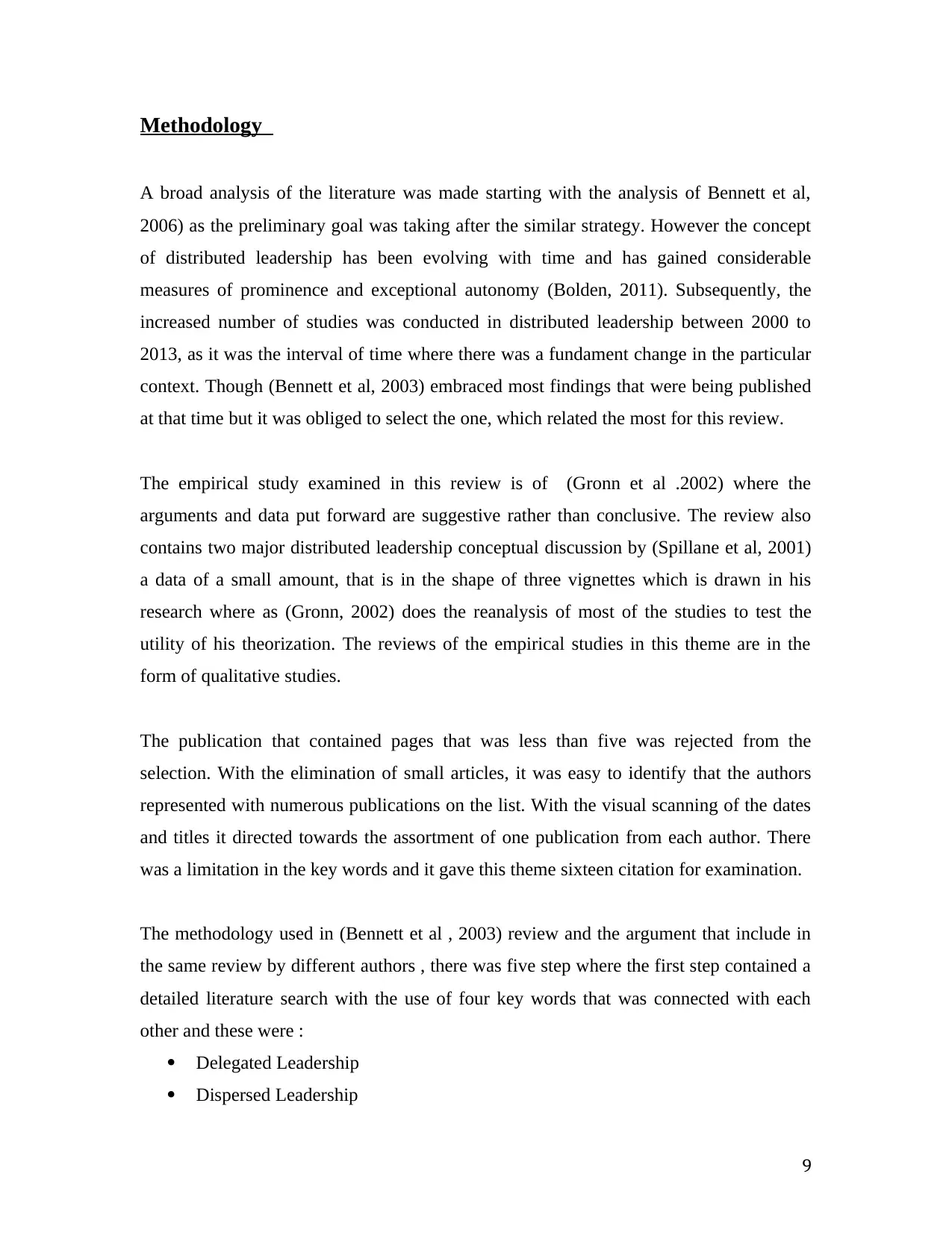
Methodology
A broad analysis of the literature was made starting with the analysis of Bennett et al,
2006) as the preliminary goal was taking after the similar strategy. However the concept
of distributed leadership has been evolving with time and has gained considerable
measures of prominence and exceptional autonomy (Bolden, 2011). Subsequently, the
increased number of studies was conducted in distributed leadership between 2000 to
2013, as it was the interval of time where there was a fundament change in the particular
context. Though (Bennett et al, 2003) embraced most findings that were being published
at that time but it was obliged to select the one, which related the most for this review.
The empirical study examined in this review is of (Gronn et al .2002) where the
arguments and data put forward are suggestive rather than conclusive. The review also
contains two major distributed leadership conceptual discussion by (Spillane et al, 2001)
a data of a small amount, that is in the shape of three vignettes which is drawn in his
research where as (Gronn, 2002) does the reanalysis of most of the studies to test the
utility of his theorization. The reviews of the empirical studies in this theme are in the
form of qualitative studies.
The publication that contained pages that was less than five was rejected from the
selection. With the elimination of small articles, it was easy to identify that the authors
represented with numerous publications on the list. With the visual scanning of the dates
and titles it directed towards the assortment of one publication from each author. There
was a limitation in the key words and it gave this theme sixteen citation for examination.
The methodology used in (Bennett et al , 2003) review and the argument that include in
the same review by different authors , there was five step where the first step contained a
detailed literature search with the use of four key words that was connected with each
other and these were :
Delegated Leadership
Dispersed Leadership
9
A broad analysis of the literature was made starting with the analysis of Bennett et al,
2006) as the preliminary goal was taking after the similar strategy. However the concept
of distributed leadership has been evolving with time and has gained considerable
measures of prominence and exceptional autonomy (Bolden, 2011). Subsequently, the
increased number of studies was conducted in distributed leadership between 2000 to
2013, as it was the interval of time where there was a fundament change in the particular
context. Though (Bennett et al, 2003) embraced most findings that were being published
at that time but it was obliged to select the one, which related the most for this review.
The empirical study examined in this review is of (Gronn et al .2002) where the
arguments and data put forward are suggestive rather than conclusive. The review also
contains two major distributed leadership conceptual discussion by (Spillane et al, 2001)
a data of a small amount, that is in the shape of three vignettes which is drawn in his
research where as (Gronn, 2002) does the reanalysis of most of the studies to test the
utility of his theorization. The reviews of the empirical studies in this theme are in the
form of qualitative studies.
The publication that contained pages that was less than five was rejected from the
selection. With the elimination of small articles, it was easy to identify that the authors
represented with numerous publications on the list. With the visual scanning of the dates
and titles it directed towards the assortment of one publication from each author. There
was a limitation in the key words and it gave this theme sixteen citation for examination.
The methodology used in (Bennett et al , 2003) review and the argument that include in
the same review by different authors , there was five step where the first step contained a
detailed literature search with the use of four key words that was connected with each
other and these were :
Delegated Leadership
Dispersed Leadership
9
⊘ This is a preview!⊘
Do you want full access?
Subscribe today to unlock all pages.

Trusted by 1+ million students worldwide
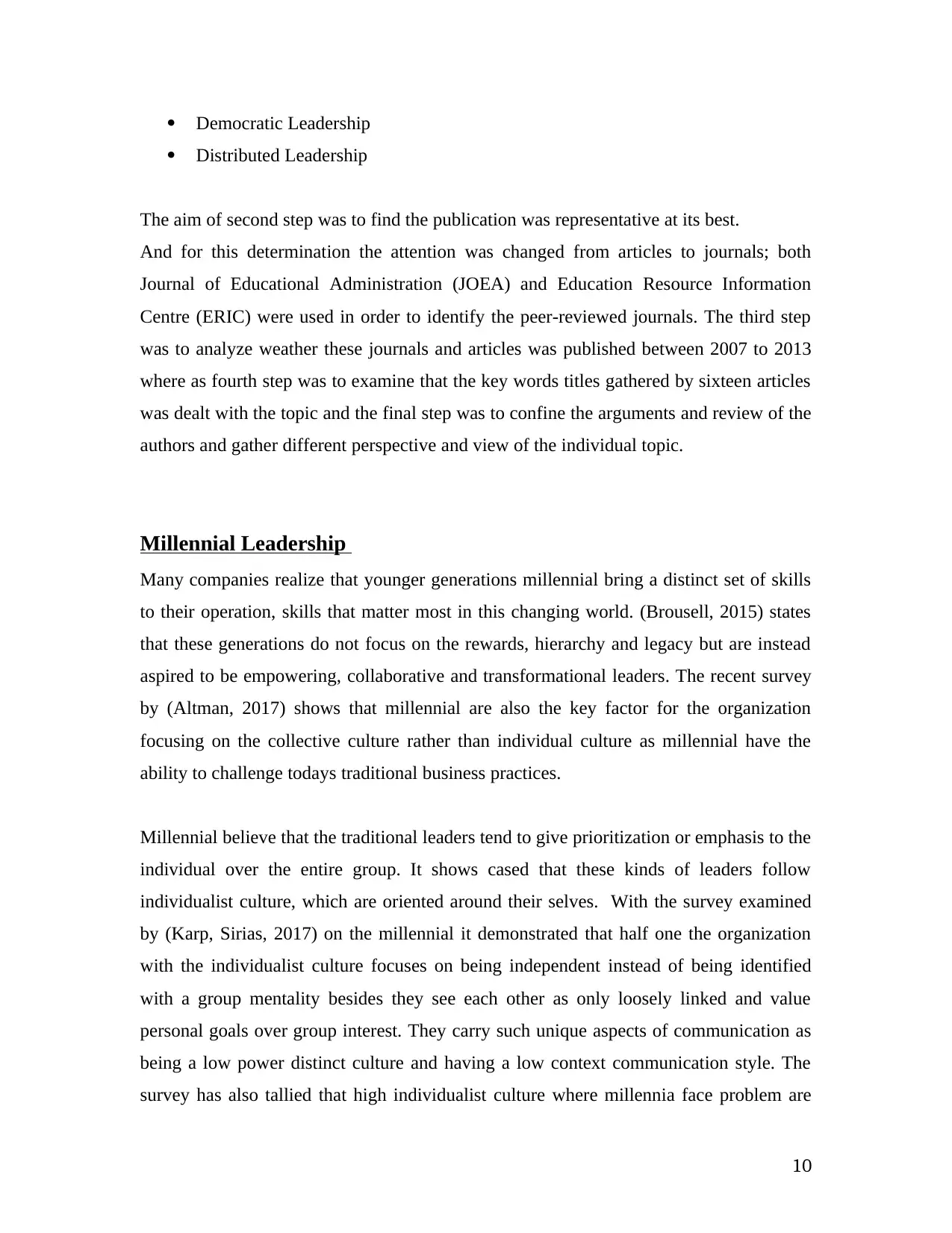
Democratic Leadership
Distributed Leadership
The aim of second step was to find the publication was representative at its best.
And for this determination the attention was changed from articles to journals; both
Journal of Educational Administration (JOEA) and Education Resource Information
Centre (ERIC) were used in order to identify the peer-reviewed journals. The third step
was to analyze weather these journals and articles was published between 2007 to 2013
where as fourth step was to examine that the key words titles gathered by sixteen articles
was dealt with the topic and the final step was to confine the arguments and review of the
authors and gather different perspective and view of the individual topic.
Millennial Leadership
Many companies realize that younger generations millennial bring a distinct set of skills
to their operation, skills that matter most in this changing world. (Brousell, 2015) states
that these generations do not focus on the rewards, hierarchy and legacy but are instead
aspired to be empowering, collaborative and transformational leaders. The recent survey
by (Altman, 2017) shows that millennial are also the key factor for the organization
focusing on the collective culture rather than individual culture as millennial have the
ability to challenge todays traditional business practices.
Millennial believe that the traditional leaders tend to give prioritization or emphasis to the
individual over the entire group. It shows cased that these kinds of leaders follow
individualist culture, which are oriented around their selves. With the survey examined
by (Karp, Sirias, 2017) on the millennial it demonstrated that half one the organization
with the individualist culture focuses on being independent instead of being identified
with a group mentality besides they see each other as only loosely linked and value
personal goals over group interest. They carry such unique aspects of communication as
being a low power distinct culture and having a low context communication style. The
survey has also tallied that high individualist culture where millennia face problem are
10
Distributed Leadership
The aim of second step was to find the publication was representative at its best.
And for this determination the attention was changed from articles to journals; both
Journal of Educational Administration (JOEA) and Education Resource Information
Centre (ERIC) were used in order to identify the peer-reviewed journals. The third step
was to analyze weather these journals and articles was published between 2007 to 2013
where as fourth step was to examine that the key words titles gathered by sixteen articles
was dealt with the topic and the final step was to confine the arguments and review of the
authors and gather different perspective and view of the individual topic.
Millennial Leadership
Many companies realize that younger generations millennial bring a distinct set of skills
to their operation, skills that matter most in this changing world. (Brousell, 2015) states
that these generations do not focus on the rewards, hierarchy and legacy but are instead
aspired to be empowering, collaborative and transformational leaders. The recent survey
by (Altman, 2017) shows that millennial are also the key factor for the organization
focusing on the collective culture rather than individual culture as millennial have the
ability to challenge todays traditional business practices.
Millennial believe that the traditional leaders tend to give prioritization or emphasis to the
individual over the entire group. It shows cased that these kinds of leaders follow
individualist culture, which are oriented around their selves. With the survey examined
by (Karp, Sirias, 2017) on the millennial it demonstrated that half one the organization
with the individualist culture focuses on being independent instead of being identified
with a group mentality besides they see each other as only loosely linked and value
personal goals over group interest. They carry such unique aspects of communication as
being a low power distinct culture and having a low context communication style. The
survey has also tallied that high individualist culture where millennia face problem are
10
Paraphrase This Document
Need a fresh take? Get an instant paraphrase of this document with our AI Paraphraser
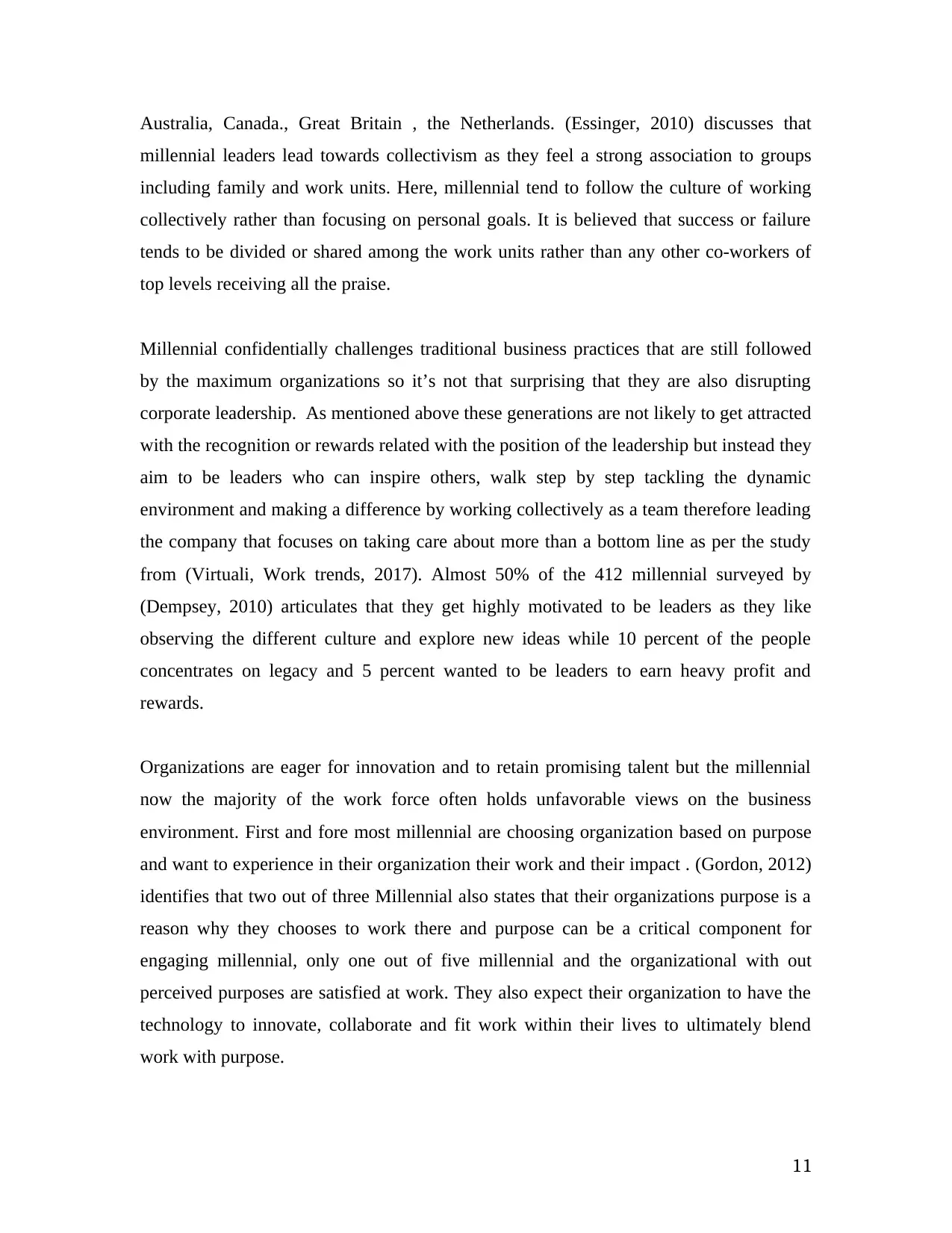
Australia, Canada., Great Britain , the Netherlands. (Essinger, 2010) discusses that
millennial leaders lead towards collectivism as they feel a strong association to groups
including family and work units. Here, millennial tend to follow the culture of working
collectively rather than focusing on personal goals. It is believed that success or failure
tends to be divided or shared among the work units rather than any other co-workers of
top levels receiving all the praise.
Millennial confidentially challenges traditional business practices that are still followed
by the maximum organizations so it’s not that surprising that they are also disrupting
corporate leadership. As mentioned above these generations are not likely to get attracted
with the recognition or rewards related with the position of the leadership but instead they
aim to be leaders who can inspire others, walk step by step tackling the dynamic
environment and making a difference by working collectively as a team therefore leading
the company that focuses on taking care about more than a bottom line as per the study
from (Virtuali, Work trends, 2017). Almost 50% of the 412 millennial surveyed by
(Dempsey, 2010) articulates that they get highly motivated to be leaders as they like
observing the different culture and explore new ideas while 10 percent of the people
concentrates on legacy and 5 percent wanted to be leaders to earn heavy profit and
rewards.
Organizations are eager for innovation and to retain promising talent but the millennial
now the majority of the work force often holds unfavorable views on the business
environment. First and fore most millennial are choosing organization based on purpose
and want to experience in their organization their work and their impact . (Gordon, 2012)
identifies that two out of three Millennial also states that their organizations purpose is a
reason why they chooses to work there and purpose can be a critical component for
engaging millennial, only one out of five millennial and the organizational with out
perceived purposes are satisfied at work. They also expect their organization to have the
technology to innovate, collaborate and fit work within their lives to ultimately blend
work with purpose.
11
millennial leaders lead towards collectivism as they feel a strong association to groups
including family and work units. Here, millennial tend to follow the culture of working
collectively rather than focusing on personal goals. It is believed that success or failure
tends to be divided or shared among the work units rather than any other co-workers of
top levels receiving all the praise.
Millennial confidentially challenges traditional business practices that are still followed
by the maximum organizations so it’s not that surprising that they are also disrupting
corporate leadership. As mentioned above these generations are not likely to get attracted
with the recognition or rewards related with the position of the leadership but instead they
aim to be leaders who can inspire others, walk step by step tackling the dynamic
environment and making a difference by working collectively as a team therefore leading
the company that focuses on taking care about more than a bottom line as per the study
from (Virtuali, Work trends, 2017). Almost 50% of the 412 millennial surveyed by
(Dempsey, 2010) articulates that they get highly motivated to be leaders as they like
observing the different culture and explore new ideas while 10 percent of the people
concentrates on legacy and 5 percent wanted to be leaders to earn heavy profit and
rewards.
Organizations are eager for innovation and to retain promising talent but the millennial
now the majority of the work force often holds unfavorable views on the business
environment. First and fore most millennial are choosing organization based on purpose
and want to experience in their organization their work and their impact . (Gordon, 2012)
identifies that two out of three Millennial also states that their organizations purpose is a
reason why they chooses to work there and purpose can be a critical component for
engaging millennial, only one out of five millennial and the organizational with out
perceived purposes are satisfied at work. They also expect their organization to have the
technology to innovate, collaborate and fit work within their lives to ultimately blend
work with purpose.
11
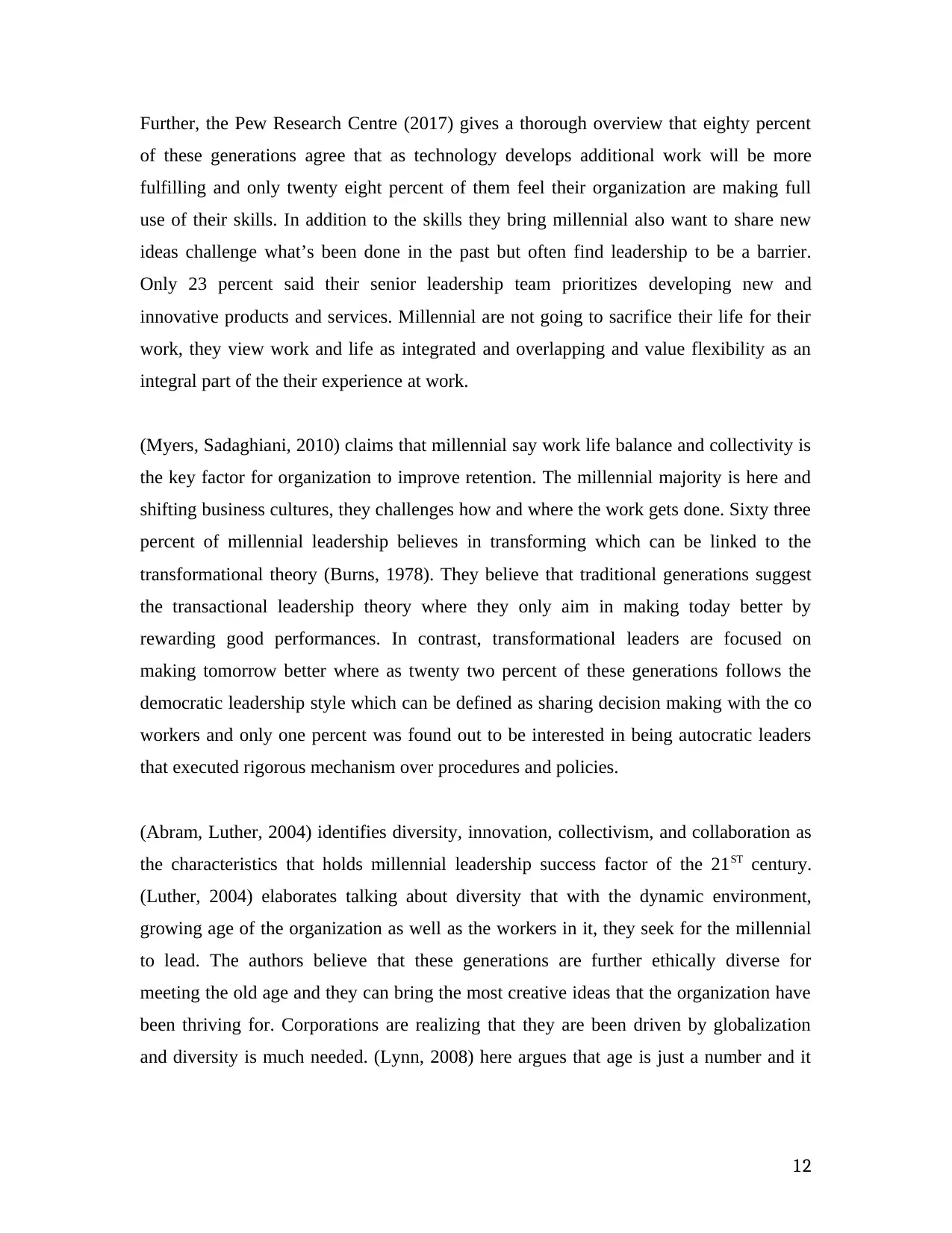
Further, the Pew Research Centre (2017) gives a thorough overview that eighty percent
of these generations agree that as technology develops additional work will be more
fulfilling and only twenty eight percent of them feel their organization are making full
use of their skills. In addition to the skills they bring millennial also want to share new
ideas challenge what’s been done in the past but often find leadership to be a barrier.
Only 23 percent said their senior leadership team prioritizes developing new and
innovative products and services. Millennial are not going to sacrifice their life for their
work, they view work and life as integrated and overlapping and value flexibility as an
integral part of the their experience at work.
(Myers, Sadaghiani, 2010) claims that millennial say work life balance and collectivity is
the key factor for organization to improve retention. The millennial majority is here and
shifting business cultures, they challenges how and where the work gets done. Sixty three
percent of millennial leadership believes in transforming which can be linked to the
transformational theory (Burns, 1978). They believe that traditional generations suggest
the transactional leadership theory where they only aim in making today better by
rewarding good performances. In contrast, transformational leaders are focused on
making tomorrow better where as twenty two percent of these generations follows the
democratic leadership style which can be defined as sharing decision making with the co
workers and only one percent was found out to be interested in being autocratic leaders
that executed rigorous mechanism over procedures and policies.
(Abram, Luther, 2004) identifies diversity, innovation, collectivism, and collaboration as
the characteristics that holds millennial leadership success factor of the 21ST century.
(Luther, 2004) elaborates talking about diversity that with the dynamic environment,
growing age of the organization as well as the workers in it, they seek for the millennial
to lead. The authors believe that these generations are further ethically diverse for
meeting the old age and they can bring the most creative ideas that the organization have
been thriving for. Corporations are realizing that they are been driven by globalization
and diversity is much needed. (Lynn, 2008) here argues that age is just a number and it
12
of these generations agree that as technology develops additional work will be more
fulfilling and only twenty eight percent of them feel their organization are making full
use of their skills. In addition to the skills they bring millennial also want to share new
ideas challenge what’s been done in the past but often find leadership to be a barrier.
Only 23 percent said their senior leadership team prioritizes developing new and
innovative products and services. Millennial are not going to sacrifice their life for their
work, they view work and life as integrated and overlapping and value flexibility as an
integral part of the their experience at work.
(Myers, Sadaghiani, 2010) claims that millennial say work life balance and collectivity is
the key factor for organization to improve retention. The millennial majority is here and
shifting business cultures, they challenges how and where the work gets done. Sixty three
percent of millennial leadership believes in transforming which can be linked to the
transformational theory (Burns, 1978). They believe that traditional generations suggest
the transactional leadership theory where they only aim in making today better by
rewarding good performances. In contrast, transformational leaders are focused on
making tomorrow better where as twenty two percent of these generations follows the
democratic leadership style which can be defined as sharing decision making with the co
workers and only one percent was found out to be interested in being autocratic leaders
that executed rigorous mechanism over procedures and policies.
(Abram, Luther, 2004) identifies diversity, innovation, collectivism, and collaboration as
the characteristics that holds millennial leadership success factor of the 21ST century.
(Luther, 2004) elaborates talking about diversity that with the dynamic environment,
growing age of the organization as well as the workers in it, they seek for the millennial
to lead. The authors believe that these generations are further ethically diverse for
meeting the old age and they can bring the most creative ideas that the organization have
been thriving for. Corporations are realizing that they are been driven by globalization
and diversity is much needed. (Lynn, 2008) here argues that age is just a number and it
12
⊘ This is a preview!⊘
Do you want full access?
Subscribe today to unlock all pages.

Trusted by 1+ million students worldwide
1 out of 26
Your All-in-One AI-Powered Toolkit for Academic Success.
+13062052269
info@desklib.com
Available 24*7 on WhatsApp / Email
![[object Object]](/_next/static/media/star-bottom.7253800d.svg)
Unlock your academic potential
Copyright © 2020–2025 A2Z Services. All Rights Reserved. Developed and managed by ZUCOL.